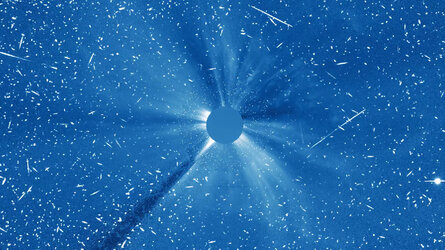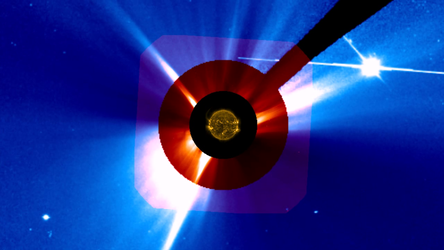Accept all cookies Accept only essential cookies See our Cookie Notice

About ESA
The European Space Agency (ESA) is Europe’s gateway to space. Its mission is to shape the development of Europe’s space capability and ensure that investment in space continues to deliver benefits to the citizens of Europe and the world.
Highlights
ESA - United space in Europe
This is ESA ESA facts Member States & Cooperating States Funding Director General Top management For Member State Delegations European vision European Space Policy ESA & EU Responsibility & Sustainability Annual Report Calendar of meetings Corporate newsEstablishments & sites
ESA Headquarters ESA ESTEC ESA ESOC ESA ESRIN ESA EAC ESA ESAC Europe's Spaceport ESA ESEC ESA ECSAT Brussels Office Washington OfficeWorking with ESA
Business with ESA ESA Commercialisation Gateway Law at ESA Careers Cyber resilience at ESA IT at ESA Newsroom Partnerships Merchandising Licence Education Open Space Innovation Platform Integrity and Reporting Administrative Tribunal Health and SafetyMore about ESA
History ESA Historical Archives Exhibitions Publications Art & Culture ESA Merchandise Kids Diversity ESA Brand Centre ESA ChampionsLatest
Space in Member States
Find out more about space activities in our 23 Member States, and understand how ESA works together with their national agencies, institutions and organisations.
Science & Exploration
Exploring our Solar System and unlocking the secrets of the Universe
Go to topicAstronauts
Missions
Juice Euclid Webb Solar Orbiter BepiColombo Gaia ExoMars Cheops Exoplanet missions More missionsActivities
International Space Station Orion service module Gateway Concordia Caves & Pangaea BenefitsLatest
Space Safety
Protecting life and infrastructure on Earth and in orbit
Go to topicAsteroids
Asteroids and Planetary Defence Asteroid danger explained Flyeye telescope: asteroid detection Hera mission: asteroid deflection Near-Earth Object Coordination CentreSpace junk
About space debris Space debris by the numbers Space Environment Report In space refuelling, refurbishing and removingSafety from space
Clean Space ecodesign Zero Debris Technologies Space for Earth Supporting Sustainable DevelopmentLatest
Applications
Using space to benefit citizens and meet future challenges on Earth
Go to topicObserving the Earth
Observing the Earth Future EO Copernicus Meteorology Space for our climate Satellite missionsCommercialisation
ESA Commercialisation Gateway Open Space Innovation Platform Business Incubation ESA Space SolutionsLatest
Enabling & Support
Making space accessible and developing the technologies for the future
Go to topicBuilding missions
Space Engineering and Technology Test centre Laboratories Concurrent Design Facility Preparing for the future Shaping the Future Discovery and Preparation Advanced Concepts TeamSpace transportation
Space Transportation Ariane Vega Space Rider Future space transportation Boost! Europe's Spaceport Launches from Europe's Spaceport from 2012Latest
Decades of the Sun, as seen by SOHO
Thank you for liking
You have already liked this page, you can only like it once!
For 25 years, the ESA/NASA SOHO observatory has captured thousands of flares, coronal mass ejections, sunspots and coronal holes that continuously break out from the Sun. This video merges decades of footage from the C2 and C3 cameras of the LASCO instrument onboard the Solar and Heliospheric Observatory from 1998 to 2020, revealing the immense power of our star.
What becomes clear as the Sun turns and years pass and background stars whirl by, is how constant the stream of material is that is blasted in all directions – the solar wind. This constant wind is interrupted only by huge explosions that fling bows of material at vast speeds, filling the Solar System with ionized material and solar radiation.
Every now and then, the entire image is shrouded in white ‘noise’. These are the moments in which solar particles are flung at near-light speeds directly at the SOHO spacecraft, causing energetic solar protons to strike LASCO’s cameras and momentarily interfere with their observations.
This means that nearby satellites orbiting Earth will also have received a direct hit just fractions of a second later, potentially damaging their onboard electronics, solar cells and creating what appears as ‘snow storms’.
Fast Coronal Mass Ejections (CMEs) are often associated with these solar particle events. Often coming from the same region of the Sun, they eject billions of tonnes of solar matter in the hours and days that follow. If they hit Earth, they can trigger geomagnetic storms – temporary disturbances in our planet’s magnetosphere.
These events can cause serious problems for modern technological systems, disrupting or damaging satellites and the multitude of services – like navigation and telecommunications – that rely on them. Geomagnetic storms can also black out power grids and disturb radio communications. Solar particle events create a radiation hazard for astronauts in space, even serving potentially harmful doses of radiation to astronauts on future missions to the Moon or Mars.
As the Sun begins a new cycle, its 25th since we’ve had enough information to count them, solar activity will begin to ramp up. In fact, we have already seen the first new sunspots and solar flares of solar cycle 25 as captured here by ESA’s Proba 2 spacecraft.
ESA’s Space Weather Office, part of the Agency’s Space Safety programme, is working to protect infrastructure on Earth and in space from the unpredictable mood swings of our star with the Lagrange mission to monitor the Sun, a distributed system of space weather sensors to better understand Earth’s space environment as a result of space weather, and the Space Weather Service Network providing timely and accurate data on space weather.
Thank you to Brendan Gallagher from the US Naval Research Laboratory who processed footage from the two LASCO cameras to create this impressive video. The US Naval Research Lab is the leading research partner for the LASCO instrument onboard SOHO.
-
CREDIT
SOHO/LASCO (ESA & NASA) - Brendan Gallagher (NRL) -
LICENCE
ESA Standard Licence
-
Closed captions available Captions and subtitles are available (automatically generated by YouTube) - select your language using the YouTube player controls. A non-YouTube version is available using the 'download' button above.
-
Animation
-
-
-
-

New view of 2012 solar activity

Framing Mercury

SOHO views X-class solar flare

SOHO’s view















 Germany
Germany
 Austria
Austria
 Belgium
Belgium
 Denmark
Denmark
 Spain
Spain
 Estonia
Estonia
 Finland
Finland
 France
France
 Greece
Greece
 Hungary
Hungary
 Ireland
Ireland
 Italy
Italy
 Luxembourg
Luxembourg
 Norway
Norway
 The Netherlands
The Netherlands
 Poland
Poland
 Portugal
Portugal
 Czechia
Czechia
 Romania
Romania
 United Kingdom
United Kingdom
 Slovenia
Slovenia
 Sweden
Sweden
 Switzerland
Switzerland

























